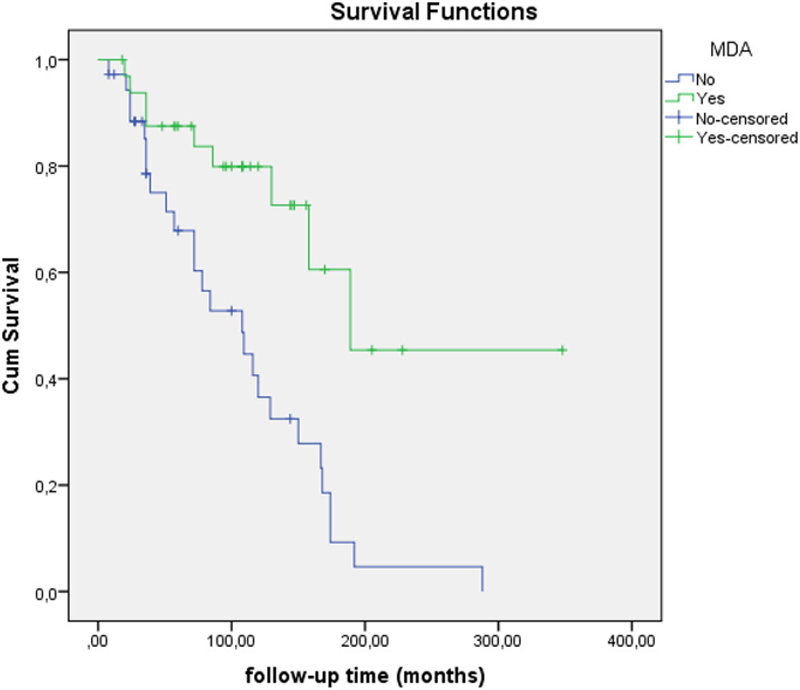

Background: Psoriatic arthritis (PsA) is a heterogeneous disease and GRAPPA have proposed Minimal disease activity (MDA) as a composite outcome measure and has been validated in PsA.
Objectives: In this study, we aimed to evaluate the characteristics, MDA frequencies, first biological disease modifying antirheumatic drugs (b-DMARD) continuation rate and associated factors in our PsA cohort.
Methods: PsA patients who fulfilled the CASPAR classification criteria and had at least six months of follow-up data were evaluated cross-sectionally for MDA.Clinical data were collected from patient charts with standard forms.b-DMARD treatment was initiated in patients who did not respond to at least one conventional synthetic (cs) DMARD for at least three months. Only anti-TNFs were used as a first line b-DMARD therefore secukinumab (Secu) was used after first line b-DMARD treatment. Adalimumab, certolizumab, etanercept, golimumab were grouped as subcutaneous (s.c) anti-TNFs. MDA was defined as meeting five out of seven criteria during follow-up [1].
Results: One hundred seventy-two patients (61% female) were included into the analysis. The mean follow-up time was 105.4±76 (6-444) months and the mean age was 50.2±13.3 (16-81) years. Mean age of onset for PsA was 38±11.9 (11-79) years; mean PsA and PsO duration were 140±90.7 (7.9-528) and 253±138 (0-756) months, respectively. Methotrexate was the most commonly used (88 %) cs-DMARD and biological DMARDs were used in 74 patients (43.3%)
Overall, 95 patients (55.2 %) were observed at MDA which was significantly lower in b-DMARD users compared to only cs-DMARD users (45.9 % vs 61.9 %; p=0.038, OR: 4.3). MDA did not differ according to PsA subtypes. The addition of cs-DMARD treatment to b-DMARDs did not affect MDA frequency In univariate analysis; higher MDA frequency was associated with older age (p=0.002), longer PsO duration (p=0.036), late onset of PsA (p=0.007) and continuation of first b-DMARD (OR:13.9 p<0.001). In multivariate analysis, older age (OR:1.3;95 % CI:1.02-1.68), late onset PsA (OR:1.03; 95 % CI:1.01-1.067) and continuation of first b-DMARD (OR:46.8; 95 % CI:1.6-1371) were associated with MDA.
Conclusion: Although frequency of MDA in our cohort was consistent with previous reports, a significant number of patients could not achieve MDA. Frequency of MDA was found to be lower in b-DMARD users compared to cs-DMARD users, possibly resulted from initiation of b-DMARD in patients with higher disease activity. Higher MDA rate was associated with higher continuation rate at first line b-DMARD treatment (TNF-inhibitor) and decreased gradually after b-DMARD switches. Although combined use of cs-DMARD with b-DMARDs did not increase the frequency of MDA, it was associated with higher b-DMARD retention. MDA is a useful outcome measure in daily follow-up of PsA patients and the importance of reaching sustained MDA for prognosis should be investigated further.
REFERENCES:
[1]Coates, L.C., J. Fransen, and P.S. Helliwell, Defining minimal disease activity in psoriatic arthritis: a proposed objective target for treatment. Ann Rheum Dis, 2010. 69 (1): p. 48-53.
b-DMARD responses, continuation rate and frequency of achieving MDA in patients with PsA
| b-DMARD treatment | Mean (median) duration (month) | Continuation rate
| Primary inefficacy
| Secondary inefficacy
| MDA
|
| First line b-DMARD (n=74) | 50.4 (36) | 37 (50) | 9 (24.3) | 17 (46) | 34 (45.9) |
| *s.c TNF inhibitors (n=62; 83.8 %) | 50.8 (35.5) | 32 (51.7) | 8 (26.7) | 9 (30) | 31 (50) |
| Infliximab (n=12; 16.2 %) | 13.8 (11) | 3 (25) | 1 (11.1) | 7 (77.8) | 3 (25) |
| Second line b-DMARD (n=29) | 28.4 (13.5) | 15 (51.7) | 5 (35.7) | 3 (21.4) | 8 (27.6) |
| *s.c TNF inhibitors (n=22; 75.9 %) | 28.6 (15) | 11 (50) | 4 (36.4) | 2 (18.2) | 5 (22.7) |
| Infliximab (n=5; 17.2 %) | 35.2 (36) | 3 (60) | - | - | 2 (40) |
| Secukinumab (n=2; 6.9 %) | 9 (9) | 1 (50) | 1 (50) | - | 1 (50) |
s.c:subcutaneous
Comparison of b-DMARD retention according to MDA status in patients with ongoing first line b-DMARD treatment Log rank: p=0.001

Disclosure of Interests: None declared